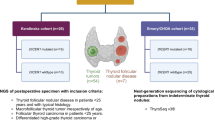Abstract
Activating mutations of GNAq protein in a hotspot at codon 209 have been recently described in uveal melanomas. Since these neoplasms share with thyroid carcinomas a high frequency of MAP kinase pathway-activating mutations, we hypothesized whether GNAq mutations could also play a role in the development of thyroid carcinomas. Additionally, activating mutations of another subtype of G protein (GNAS1) are frequently found in hyperfunctioning thyroid adenomas, making it plausible that GNAq-activating mutations could also be found in some of these nodules. To investigate thyroid papillary carcinomas and thyroid hyperfuncioning nodules for GNAq mutations in exon 5, codon 209, a total of 32 RET/PTC, BRAF, and RAS negative thyroid papillary carcinomas and 13 hyperfunctioning thyroid nodules were evaluated. No mutations were identified. Although plausible, GNAq mutations seem not to play an important role in the development of thyroid follicular neoplasms, either benign hyperfunctioning nodules or malignant papillary carcinomas. Our results are in accordance with the literature, in which no GNAq hotspot mutations were found in thyroid papillary carcinomas, as well as in an extensive panel of other tumors. The molecular basis for MAP-kinase pathway activation in RET-PTC/BRAF/RAS negative thyroid carcinomas remains to be determined.

Similar content being viewed by others
References
Dong Q, Shenker A, Way J, Haddad BR, Keming L, Hughes MR et al. Molecular cloning of human Gαq cDNA and chromosomal localization of the gαq gene (GNAQ) and a processed pseudogene. Genomics 30:470–475, 1995.
Onken MD, Worley LA, Long MD, Duan S, Council ML, Bowcock AM et al. Oncogenic mutations in GNAQ occur early in uveal melanoma. Invest Ophthalmol Vis Sci 49:5230–5234, 2008.
De Vivo M, Chen J, Codina J, Iyengar R. Enhanced phospholipase C stimulation and transformation in NIH 3T3 cells expressing Q209L Gq-alpha-subunits. J Biol Chem 267:18263–18266, 1992.
Kalinec G, Nazarali AJ, Hermout S, Xu N, Gutkind S. Mutated α subunit of the Gq protein induces malignant transformation in NIH 3T3 cells. Mol Cell Biol 12(10):4687–4693, 1992.
Landis C, Masters SB, Spada A, Pace AM, Bourne HR, Vallar L. GTPase inhibiting mutations activate the α chain of Gs and stimulate adenylyl cyclase in human pituitary tumours. Nature 340:692–696, 1989.
Oyesiku NM, Evans CO, Brown MR, Blevins LA, Tindall GT, Parks JS. Pituitary adenomas: screening for Gαq mutations. J Clin Endocrinol Metab 82:4184–4188, 1997.
Raamsdonk C, Fitch KR, Fuchs H, de Angelis MH, Barsh GS. Effects of G-protein mutation on skin color. Nat Genet 36(9):961–8, 2004.
Raamsdonk CD, Bezrookove V, Green G, Bauer J, Gaugler L, O’Brien JM et al. Frequent somatic mutations of GNAQ in uveal melanoma and blue naevi. Nature 457:599–602, 2009.
Kondo T, Ezzat S, Asa SL. Pathogenetic mechanisms in thyroid follicular-cell neoplasia. Nat Rev Cancer 6:292–306, 2006.
NCBI Nucleotide Database [Internet]. Available from: http://www.ncbi.nlm.nih.gov/nuccore
NCBI Genomic Basic Local Alignment Search Tool (BLAST) [Internet]. Available from: http://www.ncbi.nlm.nih.gov/blast/Blast.cgi
Eom HS, Kim MS, Hur SY, Yoo NJ, Lee SH. Somatic mutation of GNAQ gene is rare in common solid cancers and leukemias. Acta Oncol 48(7):1082–4, 2009.
Matsuse M, Mitsutake N, Nishihara E, Rogounovitch T, Saenko V, Rumyantsev P et al. Lack of GNAQ hotspot mutation in papillary thyroid carcinomas. Thyroid 19:1–2, 2009.
Lamba S, Felicioni L, Buttitta F, Bleeker FE, Malatesta S, Corbo V et al. Mutational profile of GNAQ 209 in human tumors. PLoS One 4(8):e6833, 2009.
Acknowledgments
Clarissa Araujo Cassol is the recipient of the grant “Strategic Training in Health Research (STIHR), STP-53912.”
Disclosure
The authors have nothing to declare.
Author information
Authors and Affiliations
Corresponding author
Rights and permissions
About this article
Cite this article
Cassol, C.A., Guo, M., Ezzat, S. et al. GNAq Mutations are Not Identified in Papillary Thyroid Carcinomas and Hyperfunctioning Thyroid Nodules. Endocr Pathol 21, 250–252 (2010). https://doi.org/10.1007/s12022-010-9129-4
Published:
Issue Date:
DOI: https://doi.org/10.1007/s12022-010-9129-4




